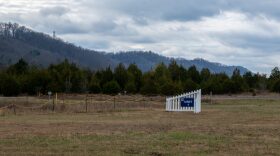This story has been edited to correct a reference to the Nuclear Regulatory Commission and to the type of governmental RFP GLE recently responded to.
A spokesperson for a company hoping to bring the world’s first commercial laser uranium enrichment facility to western Kentucky says it’s on track to test the new technology by the end of 2024.
Scientists with Global Laser Enrichment (GLE) are preparing to test the commercial capabilities of a proprietary method pioneered by one of its parent companies at a facility in Wilmington, North Carolina.
If testing is successful, GLE plans to build a more than $1 billion facility in Paducah to enrich depleted uranium to the level of natural uranium for use at other enrichment facilities or in nuclear power plants. GLE leadership estimates the facility would create several hundred permanent jobs in the Jackson Purchase Area.
Nima Ashkeboussi, vice president of government relations and communications for GLE, said in an interview last week that the company was making “significant progress on technology demonstration.”
“We're still on track to meet all the milestones that we set out to achieve at the start of the year in terms of large-scale demonstration,” Ashkeboussi said. “We have laser and separator systems and we have introduced uranium hexafluoride in those loops. We're doing some final system shakedowns before we embark on actual enrichment of the product. So we're undergoing some system checks before we actually turn the lasers on to proceed with demonstration of enrichment capabilities.”
GLE was formerly owned by General Electric and Hitachi. Now, it’s 49% owned by Canada-based nuclear fuel provider Cameco and 51% owned by Australian nuclear tech company Silex, which developed the classified technique GLE aims to use.
Laser uranium enrichment is a concept that’s existed on paper for decades. The process – in general theory – uses lasers to selectively vibrate only the uranium-235 molecules in depleted uranium before a physical method of some type is deployed to separate those from the inert uranium-238 molecules also present in spent nuclear fuel. Studies suggest that techniques utilizing laser enrichment require less space and power to operate than processes like gaseous diffusion or a gas centrifuge.
GLE has been laying the groundwork for a laser uranium enrichment facility in Paducah for years. Plans for the project have been public for more than a decade, lasting through the company’s change in ownership, the closure of the Paducah Gaseous Diffusion Plant and the shifting sentiments regarding nuclear energy in the U.S.
The company signed a deal with the U.S. Department of Energy in 2016 to use its molecular process to enrich 200,000 metric tons of depleted uranium “tails” in storage at the former PGDP site in far western Kentucky.
Local officials inked a land deal this spring giving GLE the option to acquire land adjacent to the former PGDP facility. The plot is currently owned by Kentucky Fish & Wildlife. If the option is picked up, the Paducah-McCracken County Industrial Development Authority will effectively swap the plot by the former PGDP site for a parcel of land located along the Mississippi River in Fulton and Hickman counties.
That option expires in December. Ashkeboussi said that the land deal and testing timelines are not linked and that he expects the GLE to “close [on the option] before the end of the year.”
“There's still a lot of things that need to happen to get to that point of final investment decision,” he said. “But we are comfortable … we're getting close to a place where we're ready to at least exercise the option on the land.”
The GLE vice president said the company responded to a governmental request-for-proposal in September to provide low-enriched uranium for the U.S. Department of Energy’s domestic supply of the material “needed to develop and deploy advanced [nuclear] reactors.”
Ashkeboussi also indicated that GLE plans to submit the first portion of its license application for the Paducah site to the Nuclear Regulatory Commission in December.





